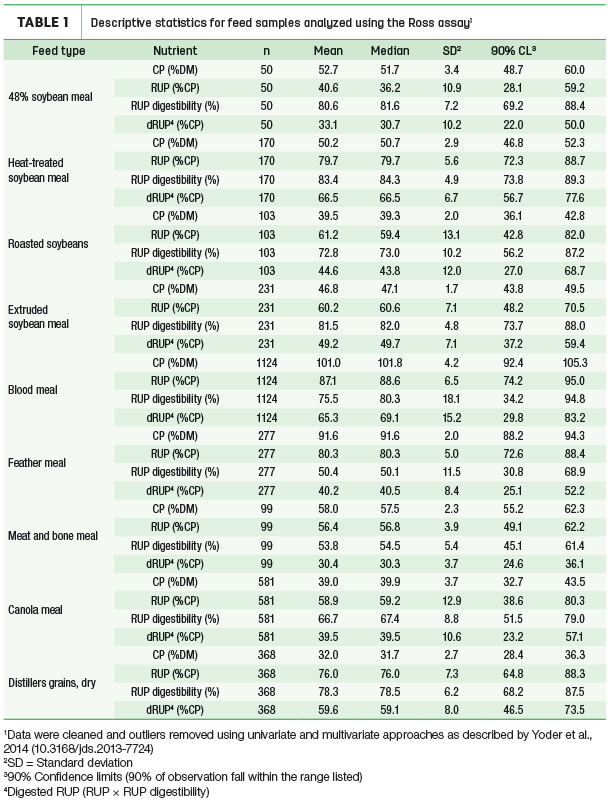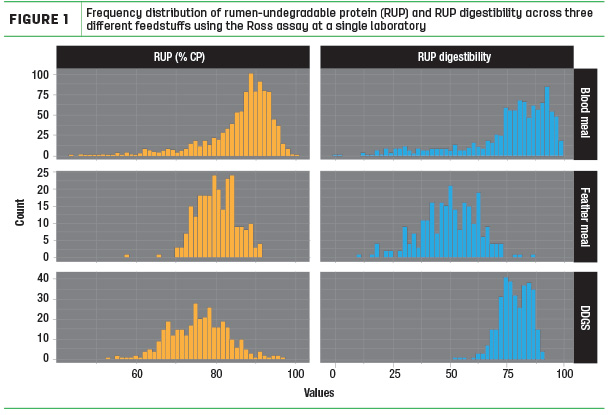This article is the second of a two-part series. Supply of digestible rumen-undegradable protein (dRUP = RUP x RUP digestibility) from high-protein feedstuffs is arguably the most important metric when determining the value of these feeds. Until recently, lab methods to quantify dRUP were not readily available. Commercial lab adaptation of the Ross assay, which can be used to quantify dRUP, has grown rapidly in recent years. The usefulness of this assay depends on a number of factors. In part I of the article, we discussed the precision and accuracy of the assay. An additional important feature of any lab assay is its ability to rank feeds from high to low quality, which will allow nutritionists and dairy farmers to make informed ingredient decisions.
Variability of feedstuffs
It is well established that some feedstuffs can vary substantially in RUP and RUP digestibility. A key aspect of the Ross assay is the ability to assess this variation in the quality of a given feedstuff. Observing this variation among samples should allow nutritionists to rank feeds within a category from highest to lowest quality and make informed purchasing and ration formulation decisions.
Variation in RUP and RUP digestibility of blood meal, feather meal and DDGS are shown in Table 1 and in frequency distribution graphs in Figure 1.


For blood meal, although the majority of the RUP digestibility data points were greater than 75% of RUP digestibility, about 25% of the data points were between 25% and 75% of RUP digestibility. The 90% confidence interval, which represents the range at which 90% of the data fall in, for RUP digestibility of blood meal was 34.2% to 94.8%. Samples with low RUP digestibility likely represent heat-damaged blood meals.
A low-RUP-digestibility blood meal means the cows won’t benefit from feeding this blood meal simply because they cannot digest it. This blood meal makes expensive fertilizer. Additionally, because RUP digestibility for blood meal is non-normally distributed, the median (80.3%) rather than the mean (75.5%) is a better indicator of the broader population of blood meals in this dataset.
It should be mentioned that the data within this population may not represent the U.S. population of blood meal, as suppliers were not randomly sampled. Samples represented may be biased toward submitters that are concerned about quality and are routinely testing blood meal. For feather meal, 90% of the RUP digestibility data points fell between 30% and 65%. As discussed previously, although the average is lower than expected, the range agrees with expectations for sample variation and likely reflects differences in hydrolysis time as well as drying time.
Some of this variation is also attributable to lower assay precision for feather meal compared to blood meal, as discussed previously. A tighter distribution in RUP digestibility was observed for DDGS, as 90% of the RUP digestibility data points were between 68% and 88%. The production of DDGS has continued to improve over the last decade; this feed has become more consistent due to a much more controlled production process. Thus, this narrow range of RUP digestibility in the Ross data agrees with our expectation.
Implications and conclusions
As discussed in part I, the Ross assay has some limitations in terms of accuracy and precision. The assay appears to be accurate for blood meal in some labs but not in others, and accuracy is a challenge for feather meal. Precision of the assay also depends on the lab. Because of these limitations, using the results of the assay as direct inputs in ration formulation programs to predict metabolizable protein (MP) and individual amino acids should be approached with caution.
Using Ross assay results that underestimate dRUP in ration formulation will lead to overfeeding of protein and unnecessary higher ration cost. On the other hand, using an overestimated digestible RUP value will lead to underfeeding of MP and will likely lead to decreased performance.
Considerable variation in RUP digestibility was observed in a large database derived from the Ross method for blood and hydrolyzed feather meal samples. This agrees with our expectations for variation in feedstuffs quality. Because the Ross assay captures variation in RUP digestibility of feeds, the assay has application in ranking high-quality versus low-quality feeds within a feedstuff and within a lab. However, because of challenges with precision and accuracy, one should use caution when using the assay to compare results between two different feedstuffs.
For example, a nutritionist submits two equal-quality samples of feather and blood meal for analysis. If RUP digestibility was overestimated for the feather meal and underestimated for the blood meal, one would incorrectly conclude that the feather meal was more digestible than the blood meal. Furthermore, a single laboratory should be used for generating data in which comparisons will be made because of lab-to-lab variation.
Despite these limitations, the Ross assay has application in ranking different sources of the same feedstuff and for helping feed manufacturers, nutritionists and dairy farmers make more informed decisions when sourcing and formulating diets with high-protein feeds.
This article is the second of a two-part series. Read Part I here.






